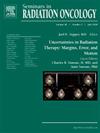Clinical Applications of Quantitative Imaging and Artificial Intelligence for Pancreatic Cance
IF 3.2
3区 医学
Q3 ONCOLOGY
引用次数: 0
Abstract
Pancreatic cancer remains as a leading cause of cancer death in the United States due to the disease’s deadly combination of evasiveness to detection, aggressive biology, and resistance to treatment. Quantitative imaging and artificial intelligence (AI) methods are emerging as promising and innovative techniques to combat the extensive challenges facing the clinic in the diagnosis and treatment of pancreatic ductal adenocarcinoma. These methods extract data from the fabric of clinical images that allow for earlier diagnosis, improved prognostication, automation of treatment planning, and increased reliability for response assessment. This review examines quantitative imaging techniques from 2013 to 2025 and summarizes them into three parts: differential diagnosis for pancreatic disease, grading and staging of pancreatic tumors, and treatment response assessment and prognosis prediction. We outline key challenges specific to pancreatic cancer and potential mitigations for future direction. We also highlight developing areas such as MRI-guided adaptive radiotherapy, automated target delineation, and integrated radiomic-omics tools that may help incorporate quantitative imaging into routine care of pancreatic cancer. Altogether, the current investigation suggests that quantitative imaging will become an integral tool for this disease across the oncologic journey of a patient.
胰腺癌定量成像与人工智能的临床应用
在美国,胰腺癌仍然是癌症死亡的主要原因,这是由于这种疾病的致命组合,难以被发现,具有侵袭性的生物学和对治疗的耐药性。定量成像和人工智能(AI)方法正在成为有前途的创新技术,以应对临床在胰腺导管腺癌的诊断和治疗中面临的广泛挑战。这些方法从临床图像结构中提取数据,从而实现早期诊断,改善预后,自动化治疗计划,并提高反应评估的可靠性。本文回顾了2013年至2025年的定量影像学技术,并将其归纳为胰腺疾病的鉴别诊断、胰腺肿瘤的分级与分期、治疗反应评估与预后预测三个部分。我们概述了胰腺癌特有的关键挑战和未来方向的潜在缓解措施。我们还强调了mri引导的自适应放疗、自动靶标描绘和集成放射组学工具等发展领域,这些工具可能有助于将定量成像纳入胰腺癌的常规护理中。总之,目前的研究表明,定量成像将成为该疾病在患者整个肿瘤过程中的一个不可或缺的工具。
本文章由计算机程序翻译,如有差异,请以英文原文为准。
求助全文
约1分钟内获得全文
求助全文
来源期刊
CiteScore
5.80
自引率
0.00%
发文量
48
审稿时长
>12 weeks
期刊介绍:
Each issue of Seminars in Radiation Oncology is compiled by a guest editor to address a specific topic in the specialty, presenting definitive information on areas of rapid change and development. A significant number of articles report new scientific information. Topics covered include tumor biology, diagnosis, medical and surgical management of the patient, and new technologies.

 求助内容:
求助内容: 应助结果提醒方式:
应助结果提醒方式:


